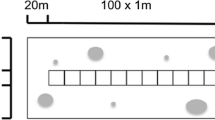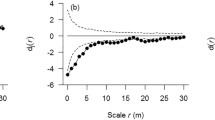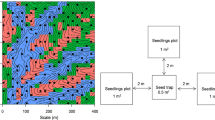Abstract
Rare plant species often suffer stronger conspecific negative density dependence (CNDD) in studies that assess the impact of local conspecific density on individual survival. All else equal, this causes a relative disadvantage among rare species that appears inconsistent with the role of CNDD in coexistence. The resolution to this apparent paradox is for lower species abundance to decrease the frequency of conspecific interactions sufficiently to outweigh the disadvantage of stronger CNDD. Whether this occurs in natural systems is untested because existing metrics do not isolate demographic impacts of CNDD, and it is also uncertain for tropical forest trees because the greater spatial aggregation observed in rare species could cause higher frequency of conspecific interactions despite lower abundance on the landscape. We develop a new metric, effective density-dependent mortality (EDDM), to quantify the proportion of individuals that are killed by density-dependent effects. We apply EDDM to a long-term study of seed fall and recruitment at Barro Colorado Island, Panama. Rare species had stronger CNDD but lower conspecific densities, and EDDM increased with abundance. Lower abundance, thus, reduces the frequency of conspecific interaction and, consequently, mortality associated with CNDD. This mechanism allows rare species to avoid a disadvantage-when-rare that would, all else equal, result from stronger CNDD in rare species. Our work provides empirical support for a resolution to the apparently paradoxical findings that rare species experience stronger CNDD and may help reconcile contrasting findings for the relationship between the CNDD strength and abundance.


Similar content being viewed by others
References
Bagchi R, Gallery RE, Gripenberg S, Gurr SJ, Lakshmi N, Addis CE, Freckleton RP, Lewis OT (2014) Pathogens and insect herbivores drive rainforest plant diversity and composition. Nature 506:85–88. doi:10.1038/nature12911
Bell T, Freckleton RP, Lewis OT (2006) Plant pathogens drive density-dependent seedling mortality in a tropical tree. Ecol Lett 9:569–574. doi:10.1111/j.1461-0248.2006.00905.x
Bever JD, Mangan SA, Alexander HM (2015) Maintenance of plant species diversity by pathogens. Annu Rev Ecol Evol Syst 46:305–325. doi:10.1146/annurev-ecolsys-112414-054306
Bolker BM, R Development Core Team (2014) bbmle: Tools for general maximum likelihood estimation. R package version 1.0.17. http://CRAN.R-project.org/package=bbmle. Accessed 1 June 2016
Bolker BM, Brooks ME, Clark CJ, Geange SW, Poulsen JR, Stevens MHH, White JSS (2009) Generalized linear mixed models: a practical guide for ecology and evolution. Trends Ecol Evol 24:127–135. doi:10.1016/j.tree.2008.10.008
Chen L, Mi X, Comita LS, Zhang L, Ren H, Ma K (2010) Community-level consequences of density dependence and habitat associations in a broad-leaved forest. Ecol Lett 13:695–704. doi:10.1111/j.1461-0248.2010.01468.x
Chesson P (2000) Mechanisms of maintenance of species diversity. Annu Rev Ecol Syst 31:343–366. doi:10.1146/annurev.ecolsys.31.1.343
Chisholm RA, Muller-Landau HC (2011) A theoretical model linking interspecific variation in density dependence to species abundances. Theor Ecol 4:241–253. doi:10.1007/s12080-011-0119-z
Comita LS, Hubbell SP (2009) Local neighborhood and species’ shade tolerance influence survival in a diverse seedling bank. Ecology 90:328–334. doi:10.1890/08-0451.1
Comita LS, Muller-Landau HC, Aguilar S, Hubbell SP (2010) Asymmetric density dependence shapes species abundance in a tropical tree community. Science 329:330–332. doi:10.1126/science.1190772
Condit R (1998) Tropical forest census plots. Springer, RG Landes Company, Berlin
Condit R, Ashton PS, Baker P, Bunyavejchewin S, Gunatilleke S, Gunatilleke N, Hubbell SP, Foster RB, Itoh A, LaFrankie JV, Lee HS, Losos E, Manokaran N, Sukumar R, Yamakura T (2000) Spatial patterns in the distribution of tropical tree species. Science 288:1414–1418. doi:10.1126/science.288.5470.1414
Connell JH (1971) On the role of natural enemies in preventing competitive exclusion in some marine animals and in rain forest trees. In: den Boer PJ, Gradwell G (eds) Dynamics of numbers in populations. Pudoc, Wgeningen, pp 289–312
Connell JH, Tracey JG, Webb LJ (1984) Compensatory recruitment, growth, and mortality as factors maintaining rain forest tree diversity. Ecol Monogr 54:141–164. doi:10.2307/1942659
Detto M, Muller-Landau HC (2013) Fitting ecological process models to spatial patterns using scalewise variances and moment equations. Am Nat 181:E68–E82. doi:10.1086/669678
Detto M, Muller-Landau HC (2016) Rates of formation and dissipation of clumping reveal lagged responses in tropical tree populations. Ecology 97:1170–1181. doi:10.1890/15-1505.1
Fricke EC, Tewksbury JJ, Rogers HS (2014) Multiple natural enemies cause distance-dependent mortality at the seed-to-seedling transition. Ecol Lett 17:593–598. doi:10.1111/ele.12261
Garwood NC (1983) Seed germination in a seasonal tropical forest in Panama: a community study. Ecol Monogr 53:159–181
Green PT, Harms KE, Connell JH (2014) Nonrandom, diversifying processes are disproportionately strong in the smallest size classes of a tropical forest. Proc Natl Acad Sci USA. doi:10.1073/pnas.1321892112
Harms KE, Wright SJ, Calderon O, Hernandez A, Herre EA (2000) Pervasive density-dependent recruitment enhances seedling diversity in a tropical forest. Nature 404:493–495. doi:10.1038/35006630
HilleRisLambers J, Clark JS, Beckage B (2002) Density-dependent mortality and the latitudinal gradient in species diversity. Nature 417:732–735. doi:10.1038/nature00809
Hubbell SP, Foster RB, O’Brien ST, Harms K, Condit R, Wechsler B, Wright SJ, De Lao SL (1999) Light-gap disturbances, recruitment limitation, and tree diversity in a neotropical forest. Science 283:554–557. doi:10.1126/science.283.5401.554
Hubbell SP, Condit R, Foster RB (2005) Barro Colorado Island forest census plot data. https://ctfs.arnarb.harvard.edu/webatlas/datasets/bci. Accessed 1 Jan 2013
Janzen DH (1970) Herbivores and the number of tree species in tropical forests. Am Nat 104:501–528
Johnson DJ, Beaulieu WT, Bever JD, Clay K (2012) Conspecific negative density dependence and forest diversity. Science 336:904–907. doi:10.1126/science.1220269
Klironomos JN (2002) Feedback with soil biota contributes to plant rarity and invasiveness in communities. Nature 417:67–70. doi:10.1038/417067a
Kobe RK, Vriesendorp CF (2011) Conspecific density dependence in seedlings varies with species shade tolerance in a wet tropical forest. Ecol Lett 14:503–510. doi:10.1111/j.1461-0248.2011.01612.x
LaManna JA, Walton ML, Turner BL, Myers JA (2016) Negative density dependence is stronger in resource-rich environments and diversifies communities when stronger for common but not rare species. Ecol Lett 19:657–667. doi:10.1111/ele.12603
Lebrija-Trejos E, Wright SJ, Hernández A, Reich PB (2014) Does relatedness matter? Phylogenetic density-dependent survival of seedlings in a tropical forest. Ecology 95:940–951. doi:10.1890/13-0623.1
Lin L, Comita LS, Zheng Z, Cao M (2012) Seasonal differentiation in density-dependent survival in a tropical rain forest. J Ecol 100:905–914. doi:10.1111/j.1365-2745.2012.01964.x
Mack KLM, Bever JD (2014) Coexistence and relative abundance in plant communities are determined by feedbacks when the scale of feedback and dispersal is local. J Ecol 102:1195–1201. doi:10.1111/1365-2745.12269
Mangan SA, Schnitzer SA, Herre EA, Mack KML, Valencia MC, Sanchez EI, Bever JD (2010) Negative plant-soil feedback predicts tree-species relative abundance in a tropical forest. Nature 466:752–756. doi:10.1038/nature09273
Queenborough SA, Burslem DFRP, Garwood NC, Valencia R (2007) Neighborhood and community interactions determine the spatial pat- tern of tropical tree seedling survival. Ecology 88:2248–2258. doi:10.1890/06-0737.1
Uriarte M, Swenson NG, Chazdon RL, Comita LS, Kress WJ, Erickson D, Forero-Montaña J, Zimmerman JK, Thompson J (2010) Trait similarity, shared ancestry and the structure of neighbourhood interactions in a subtropical wet forest: implications for community assembly. Ecol Lett 13:1503–1514. doi:10.1111/j.1461-0248.2010.01541.x
Venables WN, Ripley BD (2002) Modern applied statistics with S, 4th edn. Springer, NY
Visser MD, Bruijning M, Wright SJ, Muller-Landau HC, Jongejans E, Comita LC, de Kroon H (2016) Functional traits as predictors of vital rates across the life-cycle of tropical trees. Funct Ecol 30:168–180. doi:10.1111/1365-2435.12621
Warton DI, Hui FKC (2011) The arcsine is asinine: the analysis of proportions in ecology. Ecology 92:3–10. doi:10.1890/10-0340.1
Webb CO, Peart DR (1999) Seedling density dependence promotes coexistence of Bornean rain forest trees. Ecology 80:2006–2017. doi:10.1890/0012-9658(1999)080[2006:SDDPCO]2.0.CO;2
Wright SJ (2002) Plant diversity in tropical forests: a review of mechanisms of species coexistence. Oecologia 130:1–14. doi:10.1007/s004420100809
Wright SJ, Muller-Landau HC, Calderón O, Hernández A (2005a) Annual and spatial variation in seedfall and seedling recruitment in a neotropical forest. Ecology 86:848–860. doi:10.1890/03-0750
Wright SJ, Jaramillo AM, Pavon J, Condit R, Hubbell SP, Foster RB (2005b) Reproductive size thresholds in tropical trees: variation among individuals, species and forests. J Trop Ecol 21:307–315. doi:10.1017/S0266467405002294
Yenni G, Adler PB, Ernest SKM (2012) Strong self-limitation promotes the persistence of rare species. Ecology 93:456–461. doi:10.1890/11-1087.1
Zhu K, Woodall CW, Monteiro JVD, Clark JS (2015) Prevalence and strength of density-dependent tree recruitment. Ecology 96:2319–2327. doi:10.1890/14-1780.1
Acknowledgements
We thank Haldre Rogers, Joshua Tewksbury, Janneke Hille Ris Lambers, and Stefan Schnitzer for helpful discussion and comments on the manuscript. ECF was supported by a National Science Foundation Graduate Research Fellowship and a University of Washington Program on Climate Change Fellowship. Seed production and seedling censuses were funded by the Environmental Sciences Program of the Smithsonian Institution. The forest dynamics plot was founded by SP Hubbell and RB Foster and is now managed by R Condit, S Lao and R Perez under the Center for Tropical Forest Science and the Smithsonian Tropical Research in Panama. Numerous organizations provided funding, principally the U.S. National Science Foundation, and hundreds of field workers have contributed.
Author contribution statement
ECF conceived of the study. SJW collected field data. ECF and SJW designed the analysis and wrote the manuscript.
Author information
Authors and Affiliations
Corresponding author
Additional information
Communicated by William Stanley Harpole.
Electronic supplementary material
Below is the link to the electronic supplementary material.
Rights and permissions
About this article
Cite this article
Fricke, E.C., Wright, S.J. Measuring the demographic impact of conspecific negative density dependence. Oecologia 184, 259–266 (2017). https://doi.org/10.1007/s00442-017-3863-y
Received:
Accepted:
Published:
Issue Date:
DOI: https://doi.org/10.1007/s00442-017-3863-y




